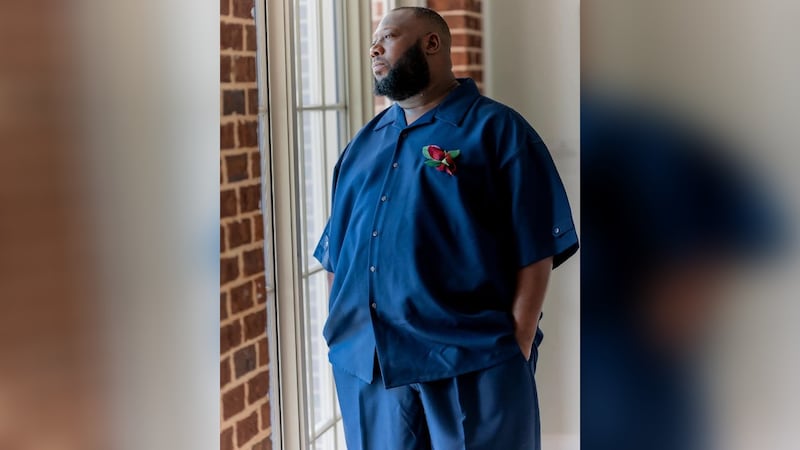GASTON COUNTY, N.C. — It's an inspiring walk the Rev. Dee Liss often takes: down the hill to see the slave cemetery.
To get there, she first enters a neatly kept traditional burying ground below Long Creek Presbyterian Church in northwest Gaston County.
Weathered markers bear the names of folks like Joseph Blackwell, killed by a musket ball at the Battle of Kings Mountain in 1780, the year Long Creek was founded.
When Liss comes to a rock wall she looks over it into the woods. And there they are - orange survey flags marking more than 90 graves of slaves and their descendants. In contrast to smooth engraved markers within the wall, those on the outside are, with a few exceptions, mostly rough field stones with no names.
Liss, the new pastor at one of the region's oldest churches, helped Long Creek get a $10,000 grant from the David Belk Cannon Foundation to professionally restore and preserve the church's traditional cemetery within the rock wall. Photos of the markers along with information on them will go onto a website available to researchers.
As the project began a few weeks ago, Lincolnton-based historic preservation consultant Jason Harpe probed a wooded area identified by church histories as the "slave cemetery."
For decades, most members knew a few graves were scattered about the tangle of undergrowth and poison ivy.
But nobody realized how many.
The recent discovery has resonated with Long Creek's membership; it's become a symbol for a newly launched effort at rediscovering the church's past and charting fresh ways of community service in the future.
"It's awesome and thrilling," Liss said of the slave cemetery. "And also humbling."
Meanwhile, the church wants to learn more about the graves from congregations at two black churches with roots at Long Creek: Good Hope Presbyterian and Ebenezer Baptist, both in Kings Mountain.
Good Hope member Allene Sellars, 85, recalled that members of the small church knew about the slave cemetery in the woods, but efforts to maintain it were few. She called Long Creek's plan to preserve the old burying ground "a wonderful idea."
The Rev. State Alexander, 95, former supply pastor at Good Hope, welcomed the attention the old cemetery is getting, and the beginning of a dialogue between the two congregations.
"I'm hoping we can still do things together," said Alexander, who lives in Charlotte.
In addition to cemetery preservation, Long Creek wants to re-establish connections with the two sister churches. Long Creek has provided financial assistance to Good Hope and will invite its young people to attend Vacation Bible School at Long Creek this summer.
"We don't have a vision yet," Liss said. "But there are limitless possibilities."
Robert Carpenter, a member of the Gaston County Historic Preservation Commission, said uncovering a large black cemetery with slaves adjacent to a white cemetery is "a very significant find."
"We haven't run into a lot of them in Gaston County," he said. "This one is very extensive. And they're still searching to figure out what all is there. I hope people can find more of these cemeteries."
Long Creek Presbyterian sits on a hill at a crossroads between Bessemer City and Kings Mountain. The oldest part of the church - built in 1875 - has original pews and heart pine floors.
Over the years, descendants continued using the old slave cemetery as a burying ground. So far, Harpe has found at least two marked headstones: Thomas Ray, who died Nov. 6, 1902, at age 76 and Joshua Daniel, who died Jan. 8, 1897, at age 91 and 18 days.
When burials there stopped, the woods took over and the old cemetery faded from memory.
When Liss came to Long Creek as interim pastor last summer, she found a small country church with about 100 members, intensely proud of their church history, wanting to know more.
She also sensed the congregation wanted to reach out in new directions and looked for someone to guide them.
Liss set out to fill that role. Under her leadership, the congregation became involved in everything from fresh approaches to Bible study to helping the jobless and homeless.
"She's lit a fire under us," said Sue Unnasch, a lifelong member of Long Creek. "She's helped us expand our thoughts."
Another longtime church member, Susan Smith, said Liss "has an energy we haven't seen in a lot of years."
For Liss, the church cemetery was a rich repository of stories. She believed that information on the 500 or so tombstones should be transcribed and presented online as a resource for both North Carolina and Presbyterian church history.
Discovery of a large slave cemetery was a bonus.
Now, the question is what to do with it. Liss is looking for more grant money to clear the ground and preserve the stones. The makers with names could be a key for genealogists to unlock lost stories.
"I love stories," Liss said. "When people tell stories, it's healing. I want to encourage our folks to learn their story as a congregation and also in terms of spiritual development."
She thinks the old burying ground in the woods can help tell it.
WSOC





